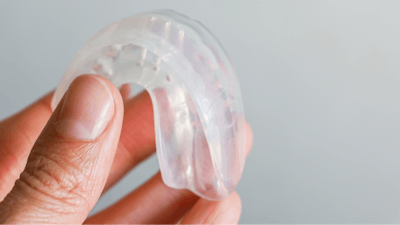
Impact performance tests revealed that custom-made 3D-printed mouthguards may provide better shock absorption than thermoformed mouthguards. The new study was published in Dental Traumatology. Additionally, the tests showed minimal thickness variation during testing and that the customized mouthguards maintained their shock absorption capacity even after repeated mechanical tests, the authors wrote.
"Custom-made 3D-printed mouthguards showed slightly better shock absorption ability than thermoformed mouthguards," wrote the authors, led by Arfi Yohan of the University Paris Cité Innovative Biomaterials and Interfaces Research Unit in France (Dent Traumatol, May 25, 2024).
To compare the impact behaviors of type II industrial mouthguards (IMGs), three-layer type III mouthguards made by thermoforming (TMGs), and type III mouthguards made by 3D printing (3DMGs), all mouthguards underwent an impact performance test, they wrote.
Eight mouthguards of each type were tested. Five impacts were performed on each mouthguard as specified by the standard for mechanical shock absorption tests. For each impact, the impactor's deceleration and the transmitted force to the mouthguard were measured. This force represents what would be transmitted to dental support during a sports injury. Higher transmitted force indicates lower shock absorption capacity of the mouthguard, they wrote.
Only IMGs met the standard, with a maximum transmitted deceleration under 250 g (2,453 m/s²). The mean maximum decelerations for 3DMGs and TMGs reached 230 g (2,256 m/s²) with maximum values over 250 g. Impact decelerations differed significantly between industrial and custom-made mouthguards.
Furthermore, for 3DMGs, both maximum deceleration and transmitted force slightly decreased with repeated impacts unlike IMGs, which showed an opposite trend. The mean reduction in thickness was 1.2 mm for IMGs, 0.6 mm for 3DMGs, and 2.2 mm for TMGs. Most TMGs showed substantial degradation at the impact point by the second trial, before completing all five impacts, they wrote.
Unlike 3DMGs and TMGs, IMGs met the mechanical shock absorption standards. However, 3DMGs nearly reached the maximum permissible values and performed better than TMGs. For 3DMGs, shock absorption improved with repeated impacts, while for IMGs, it decreased. TMGs failed at the impact point before the fifth trial, they wrote.
However, a limitation of this study was that the resin used for 3DMGs was intended for dental splints, not specifically for mouthguards, although its mechanical properties are like those of an ideal mouthguard, the authors wrote.
"3DMGs were the least damaged in the interincisal zone after a series of five impacts, with an average reduction in thickness of 0.6 mm," Yohan et al wrote. "Therefore, they may have a greater capacity to withstand successive impacts with minimal irreversible plastic deformation."




















